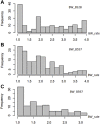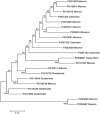Genome-Wide Association Study and Genomic Prediction for Bacterial Wilt Resistance in Common Bean (Phaseolus vulgaris) Core Collection
- PMID: 35711938
- PMCID: PMC9197503
- DOI: 10.3389/fgene.2022.853114
Genome-Wide Association Study and Genomic Prediction for Bacterial Wilt Resistance in Common Bean (Phaseolus vulgaris) Core Collection
Abstract
Common bean (Phaseolus vulgaris) is one of the major legume crops cultivated worldwide. Bacterial wilt (BW) of common bean (Curtobacterium flaccumfaciens pv. flaccumfaciens), being a seed-borne disease, has been a challenge in common bean producing regions. A genome-wide association study (GWAS) was conducted to identify SNP markers associated with BW resistance in the USDA common bean core collection. A total of 168 accessions were evaluated for resistance against three different isolates of BW. Our study identified a total of 14 single nucleotide polymorphism (SNP) markers associated with the resistance to BW isolates 528, 557, and 597 using mixed linear models (MLMs) in BLINK, FarmCPU, GAPIT, and TASSEL 5. These SNPs were located on chromosomes Phaseolus vulgaris [Pv]02, Pv04, Pv08, and Pv09 for isolate 528; Pv07, Pv10, and Pv11 for isolate 557; and Pv04, Pv08, and Pv10 for isolate 597. The genomic prediction accuracy was assessed by utilizing seven GP models with 1) all the 4,568 SNPs and 2) the 14 SNP markers. The overall prediction accuracy (PA) ranged from 0.30 to 0.56 for resistance against the three BW isolates. A total of 14 candidate genes were discovered for BW resistance located on chromosomes Pv02, Pv04, Pv07, Pv08, and Pv09. This study revealed vital information for developing genetic resistance against the BW pathogen in common bean. Accordingly, the identified SNP markers and candidate genes can be utilized in common bean molecular breeding programs to develop novel resistant cultivars.
Keywords: Curtobacterium flaccumfaciens pv. flaccumfaciens; Phaseolus vulgaris; bacterial wilt; common bean; genome-wide association study; genomic prediction; single nucleotide polymorphism.
Copyright © 2022 Zia, Shi, Olaoye, Xiong, Ravelombola, Gepts, Schwartz, Brick, Otto, Ogg and Chen.
Conflict of interest statement
The authors declare that the research was conducted in the absence of any commercial or financial relationships that could be construed as a potential conflict of interest.
Figures



Similar articles
-
Genome-Wide Association Study and Genomic Prediction of Fusarium Wilt Resistance in Common Bean Core Collection.Int J Mol Sci. 2023 Oct 18;24(20):15300. doi: 10.3390/ijms242015300. Int J Mol Sci. 2023. PMID: 37894980 Free PMC article.
-
Genome-wide association study for the extractable phenolic profile and coat color of common bean seeds (Phaseolus vulgaris L.).BMC Plant Biol. 2023 Mar 23;23(1):158. doi: 10.1186/s12870-023-04177-z. BMC Plant Biol. 2023. PMID: 36959530 Free PMC article.
-
Genome-Wide Association Study and Genomic Prediction for Soybean Cyst Nematode Resistance in USDA Common Bean (Phaseolus vulgaris) Core Collection.Front Plant Sci. 2021 Jun 7;12:624156. doi: 10.3389/fpls.2021.624156. eCollection 2021. Front Plant Sci. 2021. PMID: 34163495 Free PMC article.
-
Development of molecular markers linked to disease resistance genes in common bean based on whole genome sequence.Plant Sci. 2016 Jan;242:351-357. doi: 10.1016/j.plantsci.2015.09.006. Epub 2015 Sep 9. Plant Sci. 2016. PMID: 26566851 Review.
-
Genomics, genetics and breeding of common bean in Africa: A review of tropical legume project.Plant Breed. 2019 Aug;138(4):401-414. doi: 10.1111/pbr.12573. Epub 2018 Apr 17. Plant Breed. 2019. PMID: 31728074 Free PMC article. Review.
Cited by
-
Genome-Wide Association Study and Genomic Prediction of Fusarium Wilt Resistance in Common Bean Core Collection.Int J Mol Sci. 2023 Oct 18;24(20):15300. doi: 10.3390/ijms242015300. Int J Mol Sci. 2023. PMID: 37894980 Free PMC article.
-
Multiple-statistical genome-wide association analysis and genomic prediction of fruit aroma and agronomic traits in peaches.Hortic Res. 2023 May 31;10(7):uhad117. doi: 10.1093/hr/uhad117. eCollection 2023 Jul. Hortic Res. 2023. PMID: 37577398 Free PMC article.
-
Unlocking Nature's Shield: The Promising Potential of CRISPRa in Amplifying Antimicrobial Peptide Expression in Common Bean (Phaseolus vulgaris L.).ACS Omega. 2025 Feb 6;10(6):5909-5918. doi: 10.1021/acsomega.4c09817. eCollection 2025 Feb 18. ACS Omega. 2025. PMID: 39989781 Free PMC article.
-
Genome-wide association study for ashy stem blight resistance in USDA common bean germplasm.Front Plant Sci. 2025 May 21;16:1590571. doi: 10.3389/fpls.2025.1590571. eCollection 2025. Front Plant Sci. 2025. PMID: 40470364 Free PMC article.
-
Integrating multi-omics and machine learning for disease resistance prediction in legumes.Theor Appl Genet. 2025 Jun 27;138(7):163. doi: 10.1007/s00122-025-04948-2. Theor Appl Genet. 2025. PMID: 40579624 Free PMC article. Review.
References
-
- Allen L. H. (2013). “Legumes,” in Caballero BBT-E of HN. Third E (Waltham: Academic Press; ), 74–79. 10.1016/B978-0-12-375083-9.00170-7 - DOI
-
- Assefa T., Assibi Mahama A., Brown A. V., Cannon E. K. S., Rubyogo J. C., Rao I. M., et al. (2019). A Review of Breeding Objectives, Genomic Resources, and Marker-Assisted Methods in Common Bean (Phaseolus vulgaris L.). Mol. Breed. 39 (2). 10.1007/s11032-018-0920-0 - DOI
-
- Barili L. D., Vale N. M. d., Silva F. F. e., Carneiro J. E. d. S., Oliveira H. R. d., Vianello R. P., et al. (2018). Genome Prediction Accuracy of Common Bean via Bayesian Models. Cienc. Rural 48 (8), 1–6. 10.1590/0103-8478cr20170497 - DOI

